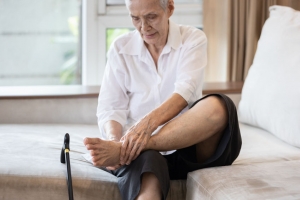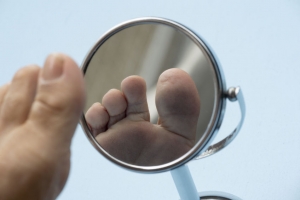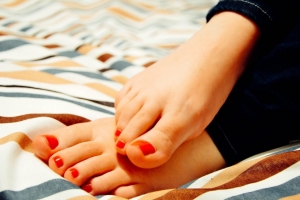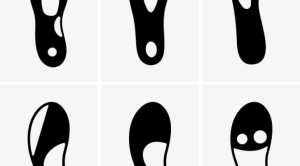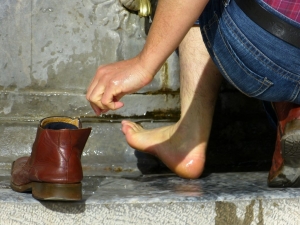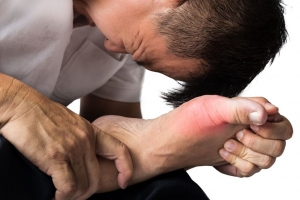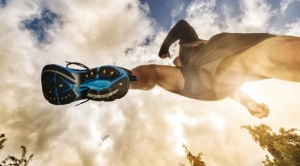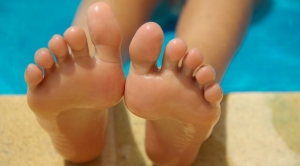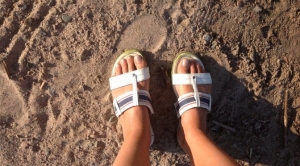Connect With Us
Blog
Displaying items by tag: Foot Care
5 Foot Care Tips for Seniors
Did you know that the average person walks between 2.5 and 5 miles a day? At Superior Foot & Ankle Care Center we know that means our Los Angeles County senior patients have likely put quite a few miles on their feet. In honor of Older Americans Month 2021, we’d like to offer some tips for protecting podiatric health as you age.
- Listen to your feet. Foot pain, shoes that don’t seem to fit properly anymore, and fatigue in your legs or feet are all ways that your feet communicate that something isn’t right. Don’t put off seeking an evaluation of these symptoms. Contact our Long Beach office at (562) 420-9800 to schedule an appointment with our podiatrists, Victoria M. Foley and Dr. Constance Ornelas.
- Keep feet clean and dry. Wash daily with soap and water and dry thoroughly (paying particular attention to the spaces between your toes). If you tend to sweat excessively, keep an extra pair of socks with you and change when you notice your feet feel damp. This will go a long way in preventing fungal infections like athlete’s foot and toenail fungus.
- Check your feet daily. Look over your entire foot (or ask someone to do it for you) for any unusual changes. Toenail or skin discoloration, bumps, bruises and swelling may all indicate a developing foot or even systemic problem. Diseases such as diabetes, hypertension and arthritis often first manifest in the feet.
- Choose shoes wisely. Your footwear is one of the biggest predictors of podiatric health. Look for styles that have good arch support and heel and insole cushioning. Treads should be non-slip but not have rubber over the toes which can lead to tripping. Ask the podiatrist for recommendations of shoe styles if you have a deformity such as a bunion or hammertoe. Lastly, get your feet professionally measured to ensure a proper fit and always try on both shoes before purchasing.
- Reduce fall risk. Falls are the number one cause of both fatal and non-fatal injuries in seniors. Safeguard your home by installing additional stair rails and lighting. Remove throw rugs, plant stands, electrical cords that are across walking areas, and other clutter to lower your chances of falling.
Your podiatrist is your partner in making sure your feet continue to be healthy and enable you to keep on living the active life you love. If you have any questions or concerns, don’t hesitate to contact us.
April is National Foot Health Awareness Month
Feet are often taken for granted and not given much attention, but in April we celebrate National Foot Health Awareness Month. At Superior Foot & Ankle Care Center, we want to take this opportunity to share with our Los Angeles county patients some simple steps you can take to protect the health of your feet and avoid many common podiatric disorders.
- Inspect your feet regularly. When is the last time you really looked at your feet? Changes in skin color or the condition of your toenails, unexplained bruising, lumps, and cuts that don’t heal are all potential signs of a foot problem. Many deformities like bunions and hammertoes also occur gradually. The majority of podiatric disorders can be more easily and better treated in their early stages. If you spot anything concerning, contact our Long Beach office at (562) 420-9800 and make an appointment with our podiatrists, Victoria M. Foley and Dr. Constance Ornelas, so that they can examine your feet and determine if there is an issue that needs to be addressed.
- Make smart shoe choices. One of the most important determining factors for the health of your feet is what you put on them. Proper fit is essential. Don’t wear shoes that feel tight or squeeze your toes together. Look for styles with roomy toe boxes, good arch support, and a firm fit around the heel. Avoid spending too much time in heels over two inches high.
- Practice good hygiene. Wash feet daily. Dust with anti-fungal or talcum powder if your feet tend to sweat excessively and moisturize at night with a good moisturizer.
- Engage in a healthy lifestyle. We sometimes forget that what we do with the rest of our body most definitely impacts the health of our feet. High cholesterol, for example, can lead to poor circulation which diminishes the ability of oxygen and nutrients needed for healing to reach your feet in a timely manner. Eating a nutritious diet, maintaining a healthy weight, not smoking, and exercising regularly will all benefit your feet as well.
If you have questions about how to best take care of your feet and ankles, contact us today.
Home Plantar Wart Treatment
How To Treat Plantar Warts At Home
A plantar wart is one of just a few soft tissue conditions, which can be very painful. It is also very common, and can be treated at home with common household items or over-the-counter products.
Treating Plantar Warts: Causes and Symptoms
Plantar warts are caused by a virus which invades the skin through small or even invisible cuts and abrasions. It is most often contracted while walking barefoot on dirty surfaces or littered areas.
Communal bathing facilities and other warm, moist environments are also breeding grounds for the virus.
Plantar warts are found on the bottom of the feet. They tend to be hard and flat, with a rough surface and defined boundaries. They are often gray or brown (colors may vary) with one or more pinpoints of black. Left untreated, the warts may grow to an inch or more and may even spread into clusters (often called mosaic warts).
These warts are very resistant to treatment, and may even return after healing; but some have been known to disappear on their own. Though warts may be painful on weight-bearing areas of the feet (e.g. the ball of the foot or the heel), most warts are harmless.
Read more about warts and how to identify them here.
Plantar Wart Treatments: Home remedies
Peeling Medicine
Nonprescription wart removal methods typically come as a patch or liquid. The directions usually tell patients to wash the affected area and soak it for 20 minutes. Gently remove the dead tissue with a pumice stone or emery board, then apply the solution or patch. Patches are typically changed every 48 hours, while liquid applications are applied twice a day. Results may not appear for several weeks.
Cryotherapy
You may be able to get this kind of treatment from the doctor . The doctor will trim the wart with a small knife. In rare cases, local anesthetic may be administered. Then, the doctor applies liquid nitrogen with a probe or cotton swab.
Duct Tape
For this method, cover the wart with silver duct tape for six days, then soak the wart in water. Remove the dead tissue with a pumice stone or emery board, and leave the wart exposed for 12 hours. Repeat this process until the wart is gone. Keep in mind that this method has seen mixed results at best.
You may want to discuss these methods with your doctor first. Most over-the-counter wart treatments will contain acids or chemicals which destroy skin cells. An expert hand will be able to destroy the abnormal skin cells without harming the surrounding healthy tissues. Patients with diabetes, cardiovascular diseases, or circulatory disorders should avoid self-treatment entirely.
Prevention
There are a few steps to take in order to prevent plantar warts from forming:
- Avoid direct contact with warts, including your own.
- Keep feet clean and dry, and change shoes and socks daily. This basic step is essential for preventing blisters and fungal infection as well.
- Wear shoes or sandals in areas where the wart virus thrives, such as communal showers, dirty areas, and swimming and pools.
- Don’t pick at the warts, as this may cause the virus to spread.
Reserve a different pumice stone or emery board for the warts, and another for healthy skin and nails. - Use a disposable emery board to avoid spreading the virus
Wash hands thoroughly after touching a wart. - Check children’s feet regularly.
When To See a Doctor
If you have a plantar wart and the treatments listed above haven’t been effective, you should see a doctor about other treatment options. Generally, it is always a good idea to see a doctor whenever there is a growth or eruption on the feet to ensure the correct diagnosis. Sometimes, what appears to be a wart may actually be a sign of cancer – for example, carcinoma or melanoma.
Ask the Experts
If you are concerned about a wart that won’t go away, schedule an appointment with Dr. Vikki or Dr. Connie today. For more foot care advice, contact the specialists at Superior Foot & Ankle Care Center.
Changing Your Shoes for the New Season
It is very important to have shoes that have just the right amount of arch support, particularly for those who transition into boots during the winter time. Seasonal Footwear all have their own unique support issues. Most boots lack the cushion and support that sneakers have while summer sandals do not provide proper ankle support.
Wearing appropriately-fitted shoes is a key part of keeping your feet healthy and in working order. You need shoes with good arch support and stable shoes, but it can be difficult to find the footwear that provides the best orthopedic fit for your feet. Without proper arch supports you leave yourself open to developing pain in your heels, ankles, knees and even lower back.
Dr. Foley and Dr. Ornelas of Superior Foot & Ankle Center have compiled a list of shoes and shoe retailers that are best suited to prevent a variety of foot-related injuries and issues. This list separates shoes by athletic categories, such as running, cross-training, basketball, hiking and golf. To avoid these problems you should always find shoes that have just the right amount of arch support or else wear orthotic insoles.
Here’s some information about what orthotics are and what different kinds are available.
What are Orthotics?
Orthotics are inserts that correct a number of foot-related problems from flat feet to heal pain. While they do not fix any major biomechanical problems with your feet, they do provide relief for minor aches and pains.
Over the Counter Orthotics
There are a number of different kinds of over-the-counter orthotics that treat minor foot problems and alleviate pain. For example, arch supports can help correct fallen arches or flat feet while gel inserts help relieve foot and heel pain.
Prescription Orthotics
If you find that over-the-counter orthotics are not alleviating your pain, and it is best to consult a foot care professional about getting prescription orthotics. Prescription orthotics are high-quality inserts that address your specific foot care needs. These custom orthotics correct any number of serious foot problems from plantar fasciitis to abnormal motion. In addition, custom orthotics can relieve severe pain in your feet, knees, shins and back. They can even be used to help diabetic treat their painful foot ulcers and calluses. Prescription Orthotics are created by taking a mold or scan of your feet, so you know that your individual foot issues are being addressed.
Other Things You Should Know
You can find orthotics that are designed to fit and work inside high heel shoes.
Because over the counter orthotics can take a while to break in it is best to wear them around the house for a few days before wearing them to work. Many shoe brands come with extra padding and support. For example Cole Haan dress shoes and boots all come with Nike Air inserts.
Over the counter inserts can last anywhere from 3 months to a year, depending upon how much standing and walking you do at your job. For this reason, people with jobs that require a lot of standing and walking such as nurses and waitresses should have a spare pair of inserts just in case.
Now that you know the importance of having proper foot support in all of your shoes no matter what season it is, be sure to use orthotics to correct and prevent pain. If you are experiencing foot pain, no matter how minor, it is important to speak to a foot care professional as soon as possible to discuss ways to correct this issue. If you have any questions about orthotics; please feel free to contact us today to schedule a consultation.
Treating Blisters Without Your Doctor’s Help
Treating Your Blister
Although most blisters eventually heal on their own, the recovery time required isn’t a feasible option for those who are active or experiencing pronounced pain. It is important to know the right methods of treatment to remain healthy and to prevent your blister from getting worse.
What Causes a Blister?
Blisters occur when temperatures rise, causing the feet to swell and sweat. This results in additional friction formed between the feet and shoes, creating a fluid-filled sac around the affected area.
Treating An Unbroken Blister
The treatment method depends on where the blister is located and its level of severity. An unbroken blister or a blood blister will heal on its own. All that is required is a bandage to protect it, and avoidance of the activities which caused or may aggravate it.
For a small blister on a weight-bearing area (such as the heel, or the ball of the foot a doughnut-shaped felt pad should be applied. Leave the area above the blister open as much as possible.
In most cases, popping a blister at home is not advised. If it is too painful, however, follow these steps to drain it safely:
- Wash both your hands and the blister with soap and warm water.
- Swab the blister with iodine.
- Take a needle or a straight pin and wipe it with rubbing alcohol.
- Gently puncture the edge of the blister.
- Press the fluid toward the hole to drain it out.
Never drain a blister, no matter how small it may be, if the following is true:
- You have diabetes, cancer, HIV, heart disease, or another condition which increases the risk of infection.
- You have reason to believe that the blister was caused by a contagious disease, such as chickenpox. If you drain this type of blister, the virus may spread to other people.
Treating a Torn (Or Drained) Blister
Once the blister has torn or drained, follow these steps:
- Wash the area with soap and water – not alcohol, iodine, or any other cleanser.
- Leave the flap of skin over the blister, unless there is dirt or pus under it. Smooth the flap over the exposed layer of skin.
- Apply antibiotic ointment such as Bacitracin or Triple antibiotic ointment and then a clean bandage. If an itch or rash develops, discontinue the ointment, since there may be a skin reaction.
- Change the bandage whenever it becomes wet or dirty, and remove it every night so the affected area can dry. If you are going to remain active as the blister heals, you may find Band Aid blister cushions or 2nd Skin blister pads particularly helpful.
When To Call a Doctor
Call your doctor if the following occur:
Monitor the area closely for signs of an infection. These may include: increased pain, swelling, redness, or warmth surrounding the blister; red streaks extending from the blister; drainage of pus; or fever.
Call your doctor if you notice these symptoms:
- A crusty blister which drains honey-colored fluid.
- Signs of illness, such as shaking chills, fever, belly pain, vomiting, diarrhea, muscle or joint aches, headaches, or a vague sense of illness.
- Symptoms do not improve, or increase in severity and/or frequency.
Preventing Blisters
Since blisters are caused by the friction between your feet and your shoes, wear shoes that fit well. This means that you should be able to wiggle your toes inside the shoe. Your feet swell later in the day, so try on shoes in the afternoon or the evening.
Moisture-wicking socks help reduce the swelling of the feet and friction associated with blisters. There are other socks and insoles designed to prevent blistering as well.
Applying moleskin to an area of the shoe where your feet rub may also help. Dust the inside of your shoe with talcum powder.
Avoid contact with plants like poison ivy, oak, or sumac.
Avoid contact with people who have infections that can cause blisters, such as:
- Viral illness like chickenpox, shingles, genital herpes infection, and cold sores
- Bacterial skin infection
- Scabies mite infection
Ask the Expert
To learn more about keeping your feet healthy, read the 15 Steps to Fabulous Summer Feet.
For the best in foot care, schedule an appointment with specialist Dr. Vikki or Dr. Connie at the Superior Foot & Ankle Care Center today.
Does Your Foot Pain Signal a Serious Condition?
You might be surprised to learn that many diseases have foot pain as one of their symptoms. Problems with the thyroid can cause nerve sensations in the feet; or degeneration in the lower back might irritate the nerves of the spine, impeding sensation in the feet. Learning what signs to look for could improve your life or even save it.
Peripheral Arterial Disease (PAD)
PAD occurs when plaque – a fatty substance which builds up in the arteries in the legs – reduces blood flow to the lower legs and feet. Symptoms include cramping in the calves, or other parts of the leg while it is in motion. It may even cause foot pain, or prevent wounds in the foot from healing properly.
While the most obvious symptoms of PAD involve the legs, it is associated with hidden damage to the heart and brain. This means that PAD sufferers are at a higher risk of heart attack and stroke. Smoking, diabetes, high cholesterol, and high blood pressure will also increase the risk of PAD. Medications may be prescribed, but diet and lifestyle changes are also necessary.
Rheumatoid Arthritis (RA) and Gout
The Arthritis Foundation revealed that 46 million Americans have arthritis or other chronic joint problems. Of the 1.3 million Americans who suffer from rheumatoid arthritis, 90 percent of them will experience symptoms in their foot and ankle.
RA develops when the body’s immune system mistakenly attacks the joints, causing pain and swelling. If RA reaches the feet, pain will begin in the toes, and then spread to the feet and ankles later on. The joint damage caused by RA can even change the shape of the toes and feet, given enough time. RA treatment involves medication, exercise, and sometimes surgery.
Gout is another type of arthritis caused by the accumulation of uric acid in the body. The acid collects in the joints, especially the big toes, and will cause intense, episodic pain. The acid may even cause kidney stones if it builds up there.
Gout treatment involves exercise, lots of water, avoidance of certain medications, and staying at a healthy weight. Doctors may prescribe gout patients with nonsteroidal anti-inflammatory drugs (NSAIDs), steroids, or other medications.
Diabetes
Approximately 24 million Americans have diabetes, but 6 million don’t even know it. Diabetes is a condition in which glucose, or blood sugar, builds up in the blood. While glucose is necessary to fuel the body, an excess amount will damage nerves and blood vessels in the feet, causing decreased sensation and reduced blood flow.
Other symptoms of diabetes include numbness and tingling in the feet, and severe foot infections. While many people experience foot discomfort after a long day of standing, severe foot pain out of proportion with your activity level is a problem that should be reported to your doctor. Diabetes can lead to other major foot problems as well, and possibly surgical removal of the toe, foot, or lower leg.
Diabetes can be treated with medication and regular foot exams. It also requires lifestyle changes like quitting smoking, and wearing supportive shoes to mitigate foot trauma.
For more information on foot pain or to schedule an appointment, contact Superior Foot & Ankle Care Center.
Choosing the Right Running Shoes | Superior Foot and Ankle Care Center
How to Choose the Best Running Shoe for You
Whether you’re a running novice or an experienced veteran, picking out running shoes can be a daunting task. It can be tempting to just grab the best looking pair from a popular brand, but the right shoes are imperative in preventing running-related injuries. With so many options bragging a variety of different features and claiming to help with an assortment of problems, it’s hard to know which shoes are right for you. Fortunately, there are a number of things you can keep in mind to help you make the right decision.
Shoe Buying Myths
To start, there are a number of myths surrounding running shoes. It’s important to not buy into them in order to find the best shoe for you.
There’s a Best Running Shoe
Many people choose a running shoe based on the popularity of a brand or shoe style, but everyone’s foot, running style, and needs are different. There’s no running shoe that is best for all, or even most, people. That’s why there are so many options available.
I’ve Found a Shoe I Like, so I Don’t Need to Try on Shoes Again
The same model of shoe won’t work for you forever. Models change slightly or even dramatically between years, as do your needs. Your running form can change over time due to injuries or strengthening and weakening muscles. Changes in your goals, routine, or running surface can also affect your needs. There’s also evidence that shows that alternating between different models from workout to workout can help to strengthen your ankle and foot.
The Right Shoe Will Help My Times
Your shoe won’t make you faster, but it can make you feel faster as your gait becomes more comfortable and natural. However, wear in the sole can slow you down and make you more prone to trips or falls as the shoes lose their grip. To prevent this, shoes should be replaced every 300 to 400 miles to prevent injury and ensure comfort.
Your Individual Needs
When shopping for running shoes, it’s helpful to determine your specific needs based on both the shape and size of your foot and your running style. Whenever you try on shoes, remember to bring any braces or inserts you need.
Shoe Size
When buying shoes, remember that size varies between brands and even between models within the same brand. The size you’ve worn in other shoes provide an estimate of the side you need, not a guarantee. Try on several different sizes to see what you like best. Laces should be snug and the ankle shouldn’t rub. You should have about a thumbnail’s space between your toe and the end of the box. (‘Barefoot’ style shoes are an exception. They should fit close to the toes, ‘like a glove.’) It’s helpful to try on shoes at the end of the day when they’ve swelled and are at their largest.
You should also remember that you don’t have to stick to the shoes in your gender’s section. Men with narrow feet may have luck with a women’s shoe while women with broad feet may have better luck with with a man’s shoe.
Arch Height
Like in any other shoes, having the proper support for your arch height in running shoes is important for ensuring comfort. Many running stores can help you determine your arch height, but you can also get some idea of your arch height at home using the ‘wet’ test.
Strike Location
When you foot hits the ground, it should land ankle first for the best possible form, but many people’s feet land farther forward on the foot. This can be corrected by the drop of the shoe, or the difference between the height of the toe and the height of the ankle of the shoe. A higher drop forces the foot to plant farther back.
Pronation
Pronation refers to the inward roll of the foot after the foot strikes the ground. Virtually everyone has some pronation, but there are shoes to stabilize over or under-pronation. For those who don’t need correction, minimalist or ‘barefoot’ shoes are options.
Superior Foot and Ankle Care Center
All of this information certainly provides guidance when shopping for running shoes, but what’s most important is that you find shoes that you like and makes you comfortable. If you overpronate but aren’t comfortable in any of the shoes for overpronation, not only will you be less likely to run, you may be more likely to hurt yourself, according to a 2015 study.
While finding the right shoes can be difficult, they are imperative to staying healthy while pursuing your running goals without injury. If you have difficulty finding the right pair, or suffer from a foot or ankle injury that makes running difficulty, the experts at Superior Foot and Ankle Care Center in Long Beach, California can provide you with the care and support you need to meet your goals. Contact us today to schedule an appointment and join our many satisfied customers.
How Treat and Prevent Foot Blisters
Blisters are common, especially for those who do a lot of walking or running. However, many people don’t know how to care for their blisters properly. Here are some tips for healing any blisters you may already have, and how to avoid new ones from forming:
When You Can Remove a Blister
When blisters are small and do not show any signs of infection, it is perfectly okay to pop them. Simply disinfect the area and drain before the blister can become infected. Afterward, treat the wound with antibiotic ointment.
To safely pop your blister, you should:
- Thoroughly wash your hands and the blister with water and antibacterial soap. Then cleanse the blister with rubbing alcohol or iodine.
- Gently rub your blister to see if it will pop on its own. If it doesn’t, soak your feet in warm water for 30 minutes. Then try popping it again.
- Cover the wound with antibiotic ointment and a bandage.
When You it Shouldn’t Be Remove
If your blister shows signs of redness, swelling, soreness, pus, or even pain, do not pop it. All of these symptoms may indicate that you have a serious infection, or that your blister is actually a foot ulcer. Both of these conditions require the attention of a podiatrist to be treated properly. Foot ulcers, particularly for diabetics, can become gangrenous and result in the need for amputation. If you are experiencing any of these symptoms, or if you suspect that you have a foot ulcer, seek medical attention immediately.
Blister Treatment
Blisters are often sore while they are healing, so be sure to keep your feet comfortable. For example, put extra padding on the affected area, or use a healing ointment that also provides pain relief.
Blister Prevention
In order to prevent future blisters, make sure that you always wear shoes that fit properly. In addition, avoid going sock-less while wearing shoes like sneakers or boots, particularly if you’re going to be walking for a while. When you do wear socks, be sure that they are thick and provide extra padding in sensitive area like the back of the heel. Cotton socks absorb moisture, causing blisters when the wet socks rub against your feet.
People with foot abnormalities, such as bunions, often develop blisters. If you are constantly suffering from blistering feet, consult your foot care professional.
For more foot care tips and tricks, consult the experts at Superior Foot & Ankle Care Center with all of your podiatric questions and concerns.
15 Steps to Fabulous Summer Feet
Summer can be hard on your feet, making proper foot protection a priority. Here are 15 simple steps to healthy, beautiful feet all year round:
Use Sunscreen
Protect your feet the from harsh UV rays on sunny summer days. Apply sunscreen with SPF 15 or higher to protect your skin from cancer and premature aging. Also, remember to reapply your sunscreen after swimming or sweating, even if the sunscreen claims to be waterproof.
Avoid Walking Barefoot
Walking barefoot is always dangerous, but the intense summer heat increases your risk of sustaining foot injuries. It also puts you at risk of developing plantar warts, ringworm, athlete’s foot, and other infections on the soles of your feet.
Wash Feet
Wash your feet with warm water after wading in lakes, ponds, and other stagnant bodies of water. Still water breeds bacteria, leaving you vulnerable to infection.
Treat Yourself to a Pedicure
Treating yourself to regular pedicures will ensure that both your nails and feet look their best in your chic summer styles.
Stay Hydrated
Staying properly hydrated during the hot summer months will prevent swollen feet. Proper hydration also improves your circulation, which in turn helps you fight infection.
Moisturize
Your feet are drier in the summer since you’re no longer wearing socks. Apply plenty of moisturizer in the morning after your shower to lock-in the moisture. For the best results, reapply before bed.
Wear The Right Socks
Acrylic and synthetic blend socks like CoolMax work the best to wick perspiration, preventing fungal infection. Socks that do not wick perspiration, such as those made from 100% cotton, increase your risk of developing blisters.
Prevent Blisters
Sandals can often cause blisters when they rub against bare feet. If you feel a blister developing, use extra padding such as liquid bandages to protect the affected area. If a blister does develop, be sure to treat it with antibiotic ointment after it pops.
Keep Shoes and Socks Dry
If your shoes or socks get wet, remove them. Wearing wet footwear leaves you vulnerable to developing fungal infections and blisters. Always bring a spare pair of socks and shoes if your feet could potentially get soaked.
The Right Shoes for The Right Occasion
Whether you’re going camping, hiking, boating, or running, it’s always best to wear footwear designed for the activity. Wearing improper footwear during strenuous activity can result in serious injury.
Air Out Feet
Avoid wearing closed-toe shoes and reach for sandals to let your feet breathe. If closed-toe shoes are required, be sure to take them off periodically in order to keep your feet from sweating.
Evaluate Your Flip-Flops
Flip-flops tend to cause sore feet, but that doesn’t mean that you have to avoid them. Be sure to choose flip-flops with extra padding, and avoid walking long distances in them.
Add Cushioning to Shoes.
Many summer shoes do not provide the proper cushioning to keep your feet protected and pain-free. Due to this, you should replace the cushioning in your shoes whenever possible. There are many over-the-counter insoles that will add extra cushioning on the cheap.
Inspect Old Shoes.
Old, worn-out shoes can cause blisters and other foot injuries. Be sure to assess the condition of your summer shoes, and throw away any questionable pairs.
Fore more foot care tips and inspiration, contact the experts at Superior Foot & Ankle Care Center for all of your podiatric needs.
Pregnancy and Painful Feet: Tips and Tricks for Expecting Mothers
Expecting mothers often experience swollen legs, feet, and ankles during and immediately after their pregnancies. This is due to the extra weight and stress on the feet, which causes pain after long periods of walking or standing.
For some mothers the extra weight on their feet may even cause their arches to fall, causing extreme pain. When the arches of your feet fall, you may begin to over-pronate, or turn in abnormally when walking. Over-pronation can stretch the plantar fascia, which is the tissue lining the bottom of the feet, causing a painful inflammation known as plantar fasciitis.
Edema, or swollen feet, is another common issue that expecting mothers face.
Both of these foot issues, especially when experienced together, make it extremely difficult to walk or stand for a long time. Therefore, it is vital for expecting mothers with pre-existing foot issues to discuss how their pregnancy will affect their feet with a podiatrist.
Below are a few tips for mothers to treat swollen and aching feet:
Always wear comfortable and supportive footwear
For added comfort and support, try using gel insoles.
Exercise regularly
The more you move, the more blood moves out of your legs into the rest of your body. If you find most exercise painful, try using a stationary bike or an elliptical trainer.
Drink plenty of water; avoid salt and caffeine
Staying properly hydrated helps your body flush its system of extra fluids. Therefore, drinking lots of water will help you relieve your swollen feet and ankles. Avoid consuming salt and caffeine because they cause your body to retain fluids.
Elevate and ice your feet
Elevating and icing your feet helps relieve the pain and tension associated with swollen feet and ankles.
Soak feet in warm water
Soaking your feet can relieve their pain and tension. In addition, the warm water can stimulate blood flow and reduce your swelling.
Get a foot massage
A massage is an excellent way to alleviate pain and reduce swelling. Massages stimulate blood flow and improve circulation, providing the muscles and tissues with the nourishment they need to heal. Improved circulation also reduces swelling.
Apply pain relief ointments
There are many over-the-counter pain relief ointments specially formulated for expecting mothers. These ointments help relieve pain and tension, especially from the bottoms of your feet. While these ointments are designed for pregnant women, it is best to speak to a healthcare professional before you begin using them.
Know your limits
If you find that your feet are becoming extraordinarily swollen after you walk, it is best to take breaks and to elevate your feet whenever possible.
Motherhood is beautiful, and your foot pain shouldn’t ruin the experience. Schedule a consultation with Dr. Vikki today for personalized foot care and relief.
Archives
Categories
- Featured (163)
- Blog (176)
- Ankle Care (6)
- Ankle Condition (2)
- Ankle Pain (0)
- Appointment Tips (2)
- Arch Pain (1)
- Arthritis (10)
- Athlete's Foot (6)
- Blister (1)
- Bunions (7)
- Calluses (1)
- Child Care (2)
- Circulation (1)
- Common Foot Conditions (4)
- Common Foot Problems (3)
- Corns (0)
- Custom Orthotics (1)
- Diabetes (10)
- Diabetic Foot Care (3)
- Diabetic Footwear (1)
- Edema (1)
- Exercise (4)
- Fall Prevention (1)
- Fitness (1)
- Flat Feet (2)
- Foot Care (19)
- Foot Care Safety Tips (3)
- Foot Care Tips (20)
- Foot Conditions (12)
- Foot Facts (3)
- Foot Health (6)
- Foot Odor (1)
- Foot Pain (5)
- Foot Problems (2)
- Foot Safety (1)
- Foot Surgery Tips (2)
- Foot Warts (2)
- Foot Wear (2)
- Fractures (1)
- Fungal Infection (2)
- General Health (0)
- Gout (5)
- Gout Treatment (0)
- Hammertoe (1)
- Health Tips (46)
- Heart Health (1)
- Heel Pain (0)
- Heel Spurs (0)
- Ingrown Toenails (4)
- Interesting Facts (2)
- Joint Pain (2)
- Leg Conditions (2)
- Leg Condtions (0)
- Men's Foot Health (1)
- Metatarsals (0)
- Nail Fungus (2)
- Neuropathy (1)
- Nutrition (2)
- Obesity (2)
- Osteoporosis (1)
- Pain Relief (5)
- Patient Communications (1)
- Pediatric Foot Conditions (5)
- Pediatric Foot Pain (2)
- Pedicure (1)
- Peripheral Arterial Disease (1)
- Plantar Fasciitis (2)
- Podiatrist Appointment (0)
- Pregnancy Feet (3)
- Proper Shoes (2)
- Senior Foot Care (7)
- Shoe Fit (1)
- Skin Cancer (3)
- Sports Injuries (2)
- Spring Foot Health (1)
- Summer Foot Health (2)
- Toe Pain (4)
- Uncategorized (5)
- Varicose Veins (2)
- Walking (1)
- Women Foot Health (3)
- Youth Sports (2)
